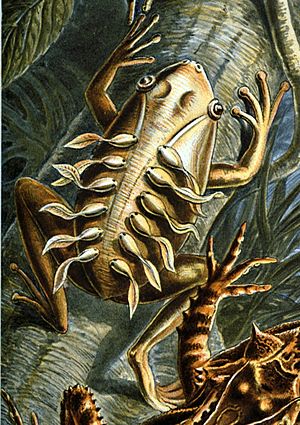Montane robber frog facts for kids
Quick facts for kids Montane robber frog |
|
|---|---|
 |
|
| Conservation status | |
| Scientific classification | |
| Synonyms | |
|
Hylodes lineatus Brocchi, 1879 |
The Montane robber frog (scientific name: Craugastor lineatus) is a type of frog. It belongs to a group of frogs called Craugastoridae. This frog lives in parts of Guatemala and southern Mexico. You can find it in areas like Oaxaca and Chiapas.
These frogs prefer to live in lower montane evergreen forests. These are forests found on mountainsides that stay green all year.
Contents
What is a Montane Robber Frog?
The Montane robber frog is a small amphibian. It is known for its unique calls. These calls help them find other frogs. They are part of a large family of frogs. This family is known for living in many different places.
Where Do These Frogs Live?
Montane robber frogs are native to Central America. They are found in specific regions. These regions include Guatemala and southern Mexico. They live in forests that are not too high up on mountains.
Habitat and Environment
These frogs need a special kind of home. They live in evergreen forests. These forests are usually moist and cool. They provide good hiding spots. The frogs find food and shelter there.
Life and Habits of the Montane Robber Frog
Montane robber frogs are mostly active at night. They hunt for small insects. They use their strong legs to jump. This helps them catch prey. It also helps them escape from danger.
What Do They Eat?
These frogs are carnivores. They eat small invertebrates. This includes insects like flies and beetles. They also eat spiders. Their diet helps control insect populations.
Reproduction and Life Cycle
Like most frogs, Montane robber frogs lay eggs. They usually lay eggs in moist places. This could be under leaves or in damp soil. The eggs hatch into tiny froglets. They do not have a tadpole stage. They grow directly into small frogs.
Conservation Status
The Montane robber frog's conservation status is "Least Concern." This means it is not currently endangered. However, their habitats can be threatened. Things like deforestation can affect them. Protecting their forests is important.
See also
 In Spanish: Craugastor lineatus para niños
In Spanish: Craugastor lineatus para niños


